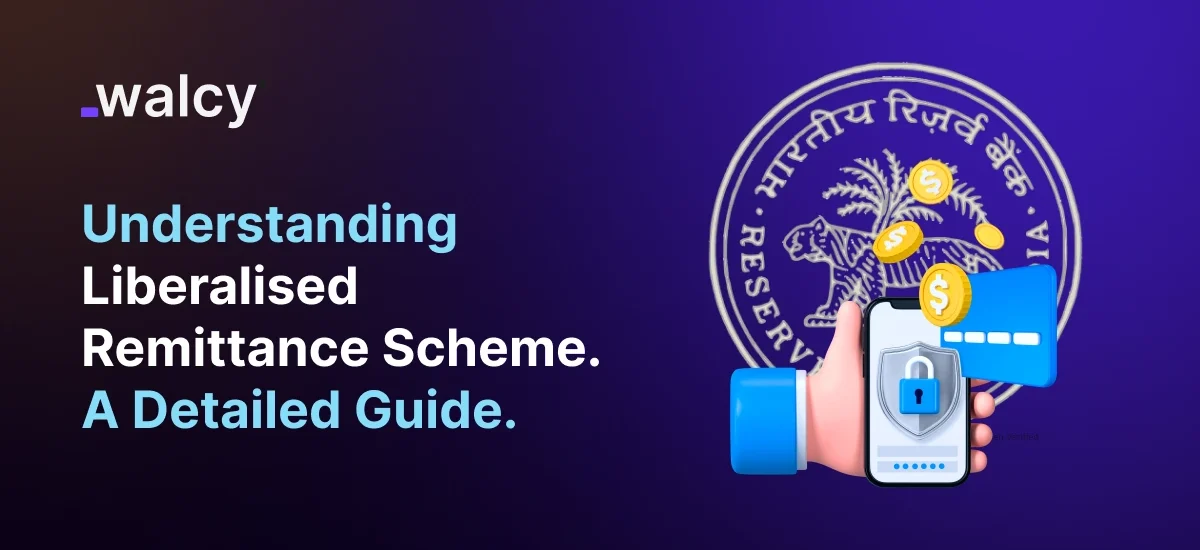Reserve Bank of India has made the Liberalised Remittance Scheme, generally called LRS, a facility to make foreign remittances much easier and more accessible to residents in India. In other words, this scheme assists residents in freely transferring money for various purposes like education, travel, investment, or medical transactions.
In this guide, we will learn in detail about the Liberalised Remittance Scheme- what the LRS is, to whom it applies, what its tax implications are, and what distinguishes it from non-LRS remittance options.
What is the Liberalised Remittance Scheme?
The Liberalised Remittance Scheme allows resident individuals of India to remit a certain ceiling amount, presently USD 250,000 per financial year, running from April to March. It could be considered for various purposes, such as:
- Travel
- Education
- Medical treatment
- Investment in stocks, bonds, or immovable property
- Gifts to NRE/FCNR account holder
- To make and maintain foreign currency accounts
Needless to say, it’s a scheme only for individuals including minors. However, it does not apply to corporations, partnership firms, HUFs, trusts, or any other entities.
Objectives and Benefits of LRS
The LRS scheme seeks to make the procedure of sending money abroad easier on the part of applicants. Before its introduction, several restrictions were imposed on remitting money, and an individual was required to go through different formalities for transferring funds under different heads.
Offering convenience for the mentioned procedures, the Liberalised Remittance Scheme comes with the following advantages:
- Ease of operation: The LRS allows sending money outside for a wide range of permissible purposes under a good deal of minimal documentation.
- Flexibility: The scheme offers flexibility for individuals in utilizing their remittance limit for one or more of the permitted many purposes. As an example, part of the funds could be used for education and the remaining part for travel.
- Control over foreign investment: The scheme of LRS permits an individual to make foreign investments in some international markets and consider various other options for investments.
Who Can Avail the Liberalised Remittance Scheme?
Any resident individual of India, including minors, can avail of the LRS. In the case of a minor, such remittance has to be made through the natural guardian on behalf of the minor. However, it cannot be availed of by corporate bodies, partnership firms, or any other artificial juridical person.
Some of the major purposes under LRS are as follows:
- Education: Residents will be able to remit money to other countries for tuition fees, living expenses, and other education-related expenses:
- Medical Treatment: An individual can obtain an LRS facility to pay for medical treatments abroad.
- Investment: Residents can make investments through LRS in foreign securities real estate or any other asset.
- Travel and Tourism: Remittances are allowed for personal or business trips to other countries.
- Gifts and Donations: Residents can remit money as gifts or donations to a friend, relative, or charitable organization abroad.
LRS-Perspective on Permissible Uses
While LRS permits a wide range of purposes, there are some limits on the purposes for which the money is permitted to be remitted. Some of the permissible purposes under the LRS scheme are as under:
- Maintenance of relatives abroad: Resident individuals are permitted to remit funds for providing maintenance to their relatives.
- Emigration: Proposed emigrants can remit under LRS for meeting some initial expenses in the country where they propose emigration.
- Overseas education and travel: one of the favorite uses of LRS relates to making a remittance to cover foreign travel and living expenses and other expenses related to education abroad.
- Specified investment in foreign securities: LRS has also facilitated investments in foreign stock markets and securities
But some exclusions are there under LRS. Under LRS, no remittances are allowed for:
- Trading in foreign exchange market
- Investment in speculative activities or margin trading
- Lottery tickets, sweepstakes, or gambling
Taxation and TCS on the Liberalised Remittance Scheme
The introduction of TCS on remittances under LRS has given adequate reason to Indian residents regarding their tax liabilities.
In a bid to bring the necessary transparency and compliance, the TCS shall be attracted to outward remittance under the following conditions:
- Education and medical treatment: TCS at 5% is attracted if such remittances for education and medical purposes exceed ₹7 lakh in a financial year.
- Others: In all the above cases, 20% TCS is attracted on an amount over ₹7 lac in a single financial year was amended in the Union Budget 2023.
- TCS paid can be claimed as a tax credit at the time of income tax return filing, but the upfront payment of 20% may lead to cash flow and planning
LRS and Double Taxation
When sending money overseas, Indian residents are more aware of double taxation agreements. India has signed the DTAA with many countries to not burden residents with double taxation for the same income.
For this, one is required to take care of the compliance issues with tax regulations in India and the destination country.
What is Double Taxation?
Double taxation occurs when the same income is taxed twice:
- In the country where it is earned (source country).
- In the country where the taxpayer resides (residence country).
For Indian residents, income earned abroad through investments or business set up using LRS remittances can potentially be taxed in the foreign country and also in India, leading to double taxation.
To address double taxation, India has signed Double Tax Avoidance Agreements (DTAA) with many countries. These agreements prevent or minimize double taxation by offering one of the following solutions:
- Exemption Method: Income is taxed only in one country.
- Tax Credit Method: If income is taxed in the foreign country, the tax paid abroad can be credited against the Indian tax liability.
Mechanism of Remitting Funds Under LRS
The mechanism for remitting funds under LRS is quite simple:
Selecting Bank:
The applicant has to approach an authorized dealer bank, i.e., a bank authorized by RBI to deal in foreign exchange, for the remittance.
Document Submission:
The following are the general documents required for remittance under the LRS:
- Form A2: This is the declaration form for the remittances.
- PAN card: To ensure compliance with payment of tax, the PAN details have to be submitted.
- Purpose of remittance: Depending on the purpose, admission letters in case of education or Invoices in case of medical treatment need to be furnished.
Complete Transaction:
Once the bank verifies all documents, remittances are affected, and funds are transferred abroad.
Non-LRS Scheme: How It Differs from LRS
It would, therefore, imply those remittance options which do not fall under the Liberalised Remittance Scheme. These usually apply to corporate entities, trusts, HUFs, and partnership firms. While LRS is designed for individuals, Non-LRS schemes provide remittance solutions for businesses and other non-individual entities.
Key differences between LRS and Non-LRS schemes include:
- Eligibility:
-
- LRS: Available to individuals, including minors.
- Non-LRS: Available to corporations, HUFs, trusts, and partnership firms.
- Purpose:
-
- LRS: The remittance can be used for education, travel, medical treatment, foreign investments, etc.
- Non-LRS: Mainly used for business-related purposes, such as the importation of goods, the payment for services, or the settlement of foreign business transactions.
- Remittance Limits:
-
- LRS: It has the following remittance limit: 250,000 USD per financial year.
- Non-LRS: No limit exists for the remittance in case of business transactions or trade, though they may be under some other legal control.
- TCS and Taxation:
- LRS: TCS would be deductible under Section 206C(1H) in respect of the amounts received by the buyer over ₹7 lakh in a financial year.
- Non-LRS: The taxation rules would depend on the nature of the business transaction involved and hence would not attract TCS in the same manner as it would have under LRS.
Importance of Understanding LRS Limits and Compliance
Understanding the Liberalised Remittance Scheme (LRS) limits and compliance is crucial for individuals and businesses for several reasons. It helps mitigate risks, manage taxes efficiently, and avoid legal complications.
Though the LRS scheme gives some flexibility, there is always a need to keep it aligned with its rules. Breach of the USD 250,000 limit without any prior approval from RBI attracts penalties or fines. Second, you will fall under the wrath of regulatory authorities if your usage of funds falls outside the permitted usage for LRS.
What If You Breach The Limit Under LRS?
LRS states that an individual cannot send more than USD 250,000 in a financial year. If the remittance amount exceeds the limit, it requires prior approval from RBI. Hence, the penalty for unauthorized remittance amounts exceeding the limit also attracts possible legal consequences.
Conclusion
LRS, therefore, is a facility given to the residents of India for sending money out of the country in an easy and simplified manner. Thus, be it for travel, education, investment, or medical treatment, the scheme grants flexibility and ease to the citizens in managing foreign remittances. However, with the recent changes in taxation-including that of individuals have to carefully plan their remittances to avoid unnecessary tax burdens.
It will be great to understand the difference between LRS and Non-LRS, more so in cases where business remittances are involved. Keeping oneself compliant with the limits and rules of LRS ensures that the benefit accruing from it can be utilized to the fullest without any legal hurdles or penalties.
Do follow us on Facebook and LinkedIn, to stay connected with us.



